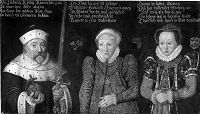Frederick III, Elector Palatine
This article needs additional citations for verification. (April 2017) |
| Frederick III | |
|---|---|
Reformed |
Frederick III of Simmern, the Pious,
Life


Frederick was strictly educated in the
When efforts at mediation failed Frederick deposed both men on 16 September 1559. To get a clear understanding of the controversy Frederick spent days and nights in theological studies and was thus led more and more to the Reformed confession. A disputation held in June 1560 between the Saxon theologians Johann Stössel and Joachim Mörlin and the Heidelbergers Pierre Boquin, Thomas Erastus, and Paul Einhorn increased Frederick's dislike for the Lutheran zealots. After the Naumburg Convention (January 1561) Frederick fully adopted the Reformed dogmas.
In March 1561 he invited
The church order of 15 November 1563 and the consistory order of 1564 consolidated the changes. The opposition of ministers inclining to Lutheranism was suppressed by their dismissal. Among the Lutherans, Frederick's measures caused a great sensation. The religious colloquy held at Maulbronn in April 1564 increased the animosity. In 1565 the Emperor Maximilian ordered the changes to be annulled. A unanimous decree of the 1566 Diet of Augsburg also demanded the abolition of the changes. Frederick, however, declared in the 14 May session of the Diet that a matter was concerned over which God alone has the rule, and if it was intended to proceed against him, he would find comfort in the promises of his Saviour. The decree was not carried out.
After completing the work of reform in the
In 1562 Frederick gave
Frederick's last years were troubled by domestic afflictions. As his older son Louis was a strict Lutheran, he could not hope that after his death his work would be carried out in his own spirit.
Family and children
Frederick III was married twice. Firstly, he married in 1537
- Alberta (4 April 1538 – 19 March 1553)
- Louis VI, Elector Palatine (4 July 1539 – 22 October 1583)
- Johann Frederick II of Saxony
- Hermann Ludwig (6 October 1541 – 1 July 1556)
- Johann Casimir (7 March 1543 – 16 January 1592); married: 1570 Elisabeth of Saxony(18 October 1552 - 2 April 1590)
- John William, Duke of Saxe-Weimar
- Albert (30 September 1546 – 30 April 1547)
- Anna Elisabeth (23 July 1549 – 20 September 1609), married:
- in 1569 to Landgrave Philipp II of Hesse-Rheinfels;
- in 1599 to Count Palatine John August of Veldenz
- in 1569 to Landgrave
- Christof (13 June 1551 – 14 April 1574)
- Karl (28 December 1552 – 12 September 1555)
- Kunigunde Jakobäa (9 October 1556 – 26 January 1586), married in 1580 to Count John VI of Nassau-Dillenburg
Secondly, he married in 1569 Amalia of Neuenahr ( 1539 – 1602), but this marriage was childless.
He died in 1576, and was succeeded as Elector Palatine by his son
Ancestors
| Ancestors of Frederick III, Elector Palatine | |||||||||||||||||||||||||||||||||||||||||||||||||||||||||||||||||||||||||||||||||||||||||||||||||||||||||||||||||||||||||||||||||||||||||||
|---|---|---|---|---|---|---|---|---|---|---|---|---|---|---|---|---|---|---|---|---|---|---|---|---|---|---|---|---|---|---|---|---|---|---|---|---|---|---|---|---|---|---|---|---|---|---|---|---|---|---|---|---|---|---|---|---|---|---|---|---|---|---|---|---|---|---|---|---|---|---|---|---|---|---|---|---|---|---|---|---|---|---|---|---|---|---|---|---|---|---|---|---|---|---|---|---|---|---|---|---|---|---|---|---|---|---|---|---|---|---|---|---|---|---|---|---|---|---|---|---|---|---|---|---|---|---|---|---|---|---|---|---|---|---|---|---|---|---|---|
| |||||||||||||||||||||||||||||||||||||||||||||||||||||||||||||||||||||||||||||||||||||||||||||||||||||||||||||||||||||||||||||||||||||||||||
Literature
- Böttcher, Hans-Joachim (2018). Elisabeth von Sachsen und Johann Kasimir von der Pfalz: Ein Ehe- und Religionskonflikt [Elisabeth of Saxony and John Casimir of the Palatinate: A Marital and Religious Conflict] (in German). Dresden: Dresdner Buchverlag. ISBN 9783946906063.
